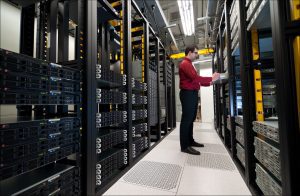The mission-critical nature of hospitals and healthcare facilities requires stakeholders to build their businesses around a philosophy of highly efficient services. The ability to manage the data stream generated within daily processes is increasingly critical to a hospital’s reputation for efficiency and professionalism. Hundreds of thousands of people suffer adverse effects yearly due to inaccurate or incomplete medical records that can affect testing, treatment, and accurate diagnosis. Integrated and improved IT solutions, like micro data centers, can help significantly reduce this number by enabling more accurate and accessible medical records, helping to facilitate better medical decisions.

Growing challenges for hospitals
The recent pandemic has added to the complexity of improving hospital efficiencies. Many hospitals have experienced backlogs, which can cause delays in patient treatments. Further, rural hospitals experience the challenge of providing patients with access to highly skilled medical professionals and specialized treatments given their distant, remote settings.
Globally, most hospitals are challenged with improving efficiencies as many have manual work processes in place, or their on-site and remote systems are not tied into one another. Numerous healthcare facilities don’t yet have the technology to support such systems. Reporting and electronic medical records are one of the areas often affected. With little or no access to patient history, many hospitals have difficulty sharing data with other hospitals.
Impact on sustainability
Efficiency also has a significant impact on sustainability. Hospitals are large consumers of energy. Much of a hospital’s energy usage stems from lighting, heating, cooling and ventilation, and hot water heating. Energy-consuming technology such as electronic imaging equipment and digital record-keeping add to this load. Remote facilities often operate at full energy use even when the offices are closed, with equipment, temperature settings, and lights running around the clock.
However, many of these high costs are avoidable. New technologies allow healthcare facility staff quick and easy access to screens that enable them to control and monitor energy consumption in patient rooms, whether occupied or unoccupied, because these rooms need to be managed differently from an energy and comfort perspective. Sensors within the rooms gather an abundance of energy consumption, comfort, and safety data. Building analytics software then converts the data into actionable intelligence, which improves the facility’s energy efficiency and boosts patient satisfaction.
How micro data centers address the hospital efficiency dilemma
There is good news for hospitals looking to improve efficiencies and sustainability efforts. Innovations in edge computing technology are improving connectivity, and high-efficiency power and cooling are helping hospitals and healthcare facilities to:
- reduce costs
- improve operational efficiency and sustainability
- enable a better patient experience
- improve profitability
IT systems and related power and cooling infrastructure now play a major role in helping hospitals to drive efficiencies across the board. Most hospitals today have a small or medium data center on-premise, primarily used to archive records. But with the increased availability of Internet of Things (IoT) technologies, significantly more devices and sensors are being connected. Vast amounts of data are flowing back and forth between departments and across healthcare facilities.
With this increase in data comes the problem of latency (delays in response times when accessing computer data) and limited bandwidth to access cloud-based applications. New medical devices are being introduced into hospital facilities on an ongoing basis, and they need to be connected to not only the hospital but also the cloud. Medical equipment providers host cloud-based diagnostic centers to help doctors and departmental staff achieve faster and more accurate patient results.
To accommodate these changes, many healthcare organizations are beginning to deploy micro data centers to enable hyper-efficiency connectivity to the cloud. Micro data centers are small preassembled, pre-tested, and integrated solutions configured into an enclosure. These micro data centers are ready to host servers, storage, and networking devices.
Also, the following components can be made ready to operate before arriving at the healthcare facility:
- racks
- power distribution units
- uninterruptible power supplies (UPS)
- management software
Such systems can be remotely monitored using tools such as EcoStruxure IT TM, a software-based data center infrastructure management system. The core elements of the system all work together so organizations in edge environments have peace of mind knowing these systems can operate on their own, typically without any local support required. Additional security devices, such as racks with card key access and server room security cameras, can also be easily added to the micro data center configuration. Healthcare institutions use these micro data centers as distributed networking sources, storage, and IT server support.
Discover micro data centers
To learn more about how compact micro data centers can help drive higher efficiencies across your healthcare environment and improve patient experiences, visit the Micro Data Centers webpage.


